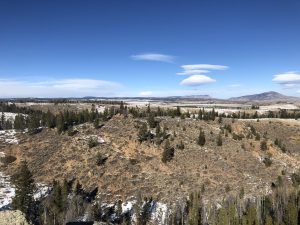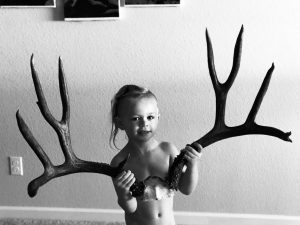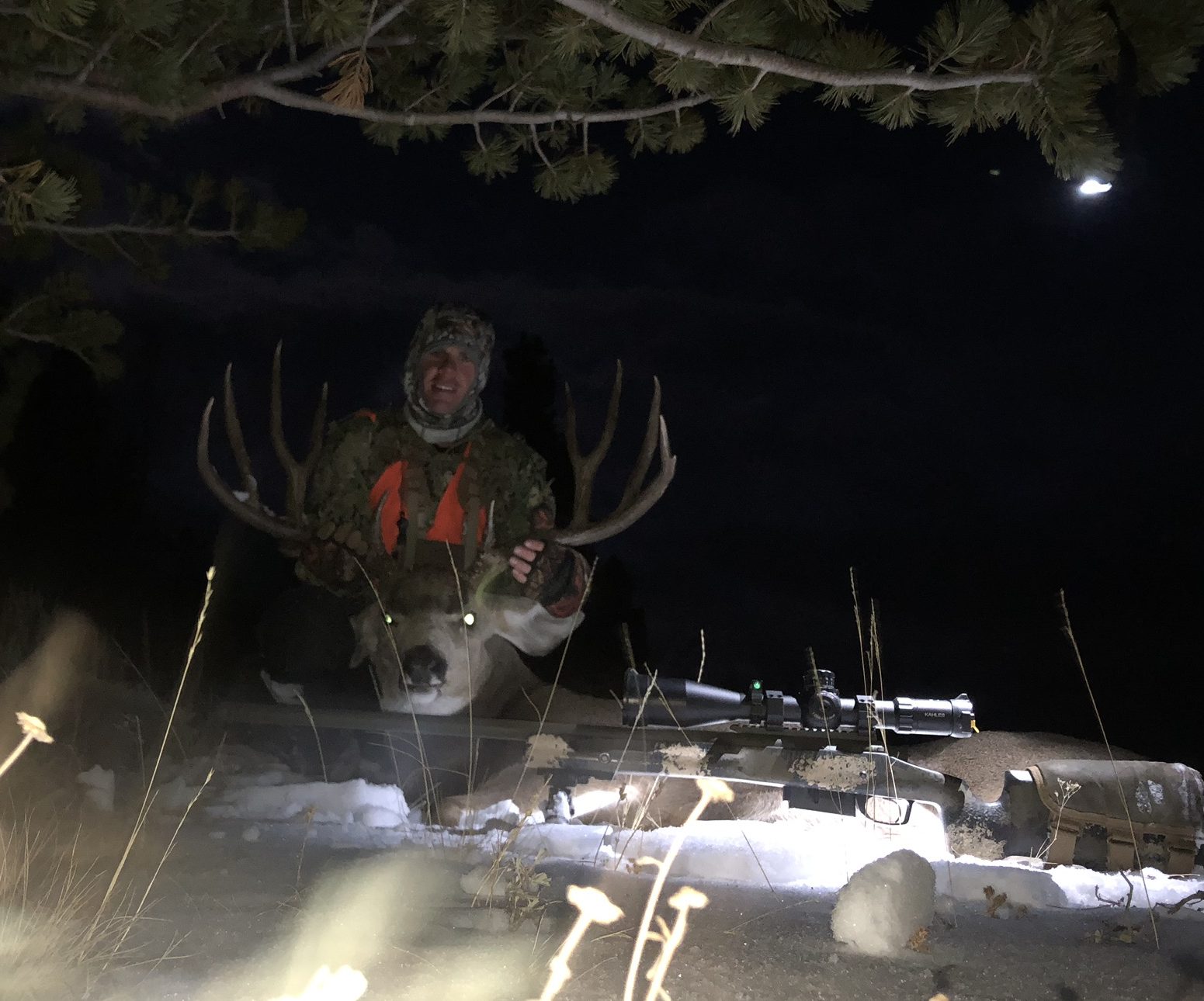This was one of the most exciting hunts I’ve been on. A large factor of what I loved about his hunt was witnessing the characteristics of mule deer in the late season. It was rewarding to see firsthand how these November Bucks act. Listening to all the podcasts and reading articles on November mule deer hunting tactics was interesting, but to see firsthand was another. The ease of access to information is an amazing thing these days, leading up to the hunt I tried to learn as much as I could about late season tactics, although I’m a rifle and archery hunter, and I‘ve been hunting since I was 12, I didn’t have experience with late season muleys. Here’s a few things that I witnessed during my hunt that coincided with my research prior to the hunt.
 Patience: This one is listed first as It’s the most important tactic with late season muleys in my opinion, and the hardest to exercise. I’ve heard in Nov, especially mid to late Nov, if you see a doe, sit on her, more than likely there’s a buck close by. Now does that mean sit on her all day? No, but you should be dedicating a decent amount of time watching to see if a buck is in the area. I sat on two doe, each had a couple fawns, for three hours from a vantage point across a canyon. They were feeding in the late morning sun 300 yards away. As I decided to move on, a small 3×3 emerged from the woods. He had probably been bedded down watching them, and at one point when they got too far away, he moved to get closer. He was small and I was after something larger. Moral of the story, dress warm during those 4th season mule hunts because
Patience: This one is listed first as It’s the most important tactic with late season muleys in my opinion, and the hardest to exercise. I’ve heard in Nov, especially mid to late Nov, if you see a doe, sit on her, more than likely there’s a buck close by. Now does that mean sit on her all day? No, but you should be dedicating a decent amount of time watching to see if a buck is in the area. I sat on two doe, each had a couple fawns, for three hours from a vantage point across a canyon. They were feeding in the late morning sun 300 yards away. As I decided to move on, a small 3×3 emerged from the woods. He had probably been bedded down watching them, and at one point when they got too far away, he moved to get closer. He was small and I was after something larger. Moral of the story, dress warm during those 4th season mule hunts because  it’s not like your chasing bugles with your bow in the archery season. You’re sitting for hours and waiting for the big buck to show. You don’t still hunt your way to the older deer and find success very often, sure it happens every year to some hunters but I can assure you, sitting on a good vantage point, preferably with some deer in sight, hedges your bet that a buck will appear.
it’s not like your chasing bugles with your bow in the archery season. You’re sitting for hours and waiting for the big buck to show. You don’t still hunt your way to the older deer and find success very often, sure it happens every year to some hunters but I can assure you, sitting on a good vantage point, preferably with some deer in sight, hedges your bet that a buck will appear.
Good Glass: One of the pieces of gear I have neglected to upgrade are binoculars. I have small 10×28 vortex’s that I bought a couple years ago, I wanted small and light for long backcountry trips.

Whether I’m archery hunting or carrying my heavy bull barreled rifle for long range hunting, I try to cut weight where possible. However, glass is not where you want to cut weight, glass is arguably the most important piece of gear with regards to being successful on a hunt, it’s like the importance of water to survival. If your going to spend all the money that we as hunters spend on gear, and dedicate the time away from family, not to mention the long miles on legs if you’re a backcountry hunter like myself, it doesn’t make sense to skimp on a piece of gear that enables you to spot the animal you’re hunting. After all, that’s the entire objective.

Practice shooting from different positions: Both bucks I saw came out of the woods on a mission, they never stopped moving. They were doing a very fast walk, almost trot, with the their heads down chasing does around checking to see if they were in heat. When I shot my buck it was at dusk, within the last 10 minutes of light. He came trotting out into a meadow with two feeding does. He chased them around running back and forth across this meadow that was about the size of a football field. It was weird yet exhilarating to see, he just kept trotting between the two doe chasing them back and forth, and luckily neither doe left the meadow, they just ran in circles. I was laying prone and had a position set up the previous three hours so I felt confidence.
After 5 minutes he finally stopped to check a urine spot but starting walking, this time he was getting too close to the tree line and disappearing from my life entirely, and I couldn’t take that chance. He was walking at a fairly slow pace and it was a 490 year shot. I led him off the front shoulder and sent a shot right where I had predicted, high shoulder. He dropped in his tracks and expired in seconds. This was with my 6.5 PRC shooting a 147g ELD-M at 3040 fps. I had shot a bull elk three weeks prior that went 40 yards and dropped.

Moral of the story, practice in common shooting positions, start with prone but don’t bank on always being able to shoot prone, practice shooting prone off your hunting pack as well as shooting sitting utilizing shooting sticks for front and even rear support. If in theory, I had just walked to this location and saw this buck and I wasn’t already set up in a prone position, I would probably drop down and shoot off the pack without even taking the time to extend my bipod, as long as the position was solid. If the same situation happened and I was in tall grass or brush, I would have used my shooting sticks with my backpack in my lap to rest my elbows on. Remember, always try to support the position using as much bone structure rather than muscle support as possible.
In conclusion:
I shot my Buck on 16NOV2018. The next day he was measure at 200 ¼”. After the mandatory 60 day drying time, B&C officials will come to my house and give it an official measurement to see if he qualifies for input. I’m not a trophy hunter, but I am proud that I harvested a deer that lived a natural life in the wild and was nearing his end. Do I need the meat? No. That argument for hunters is lost. Do I want organic healthy meat as an alternative to farm raised beef, hell yes I do. Is meat on the mountain earned more than meat in the grocery store, hell yes it is. To all non-hunters out there, if you eat meat and you are anti-hunting, you’re a hypocrite. If you don’t understand the simplicity of hypocrisy as it relates to this, than it’s probably not worth my time explaining myself. To a lighter side, I highly recommend trying a late season hunt, I think you’re going to be in for a treat. I can’t wait for next year, safe to say that I’m hooked
Backcountry Precision
Blood. Sweat. Reward


https://shorturl.fm/TDuGJ
https://shorturl.fm/0oNbA
https://shorturl.fm/f4TEQ
https://shorturl.fm/LdPUr
https://shorturl.fm/nqe5E
https://shorturl.fm/68Y8V
https://shorturl.fm/A5ni8
https://shorturl.fm/6539m
https://shorturl.fm/YvSxU
https://shorturl.fm/N6nl1
https://shorturl.fm/6539m
https://shorturl.fm/TbTre
https://shorturl.fm/FIJkD